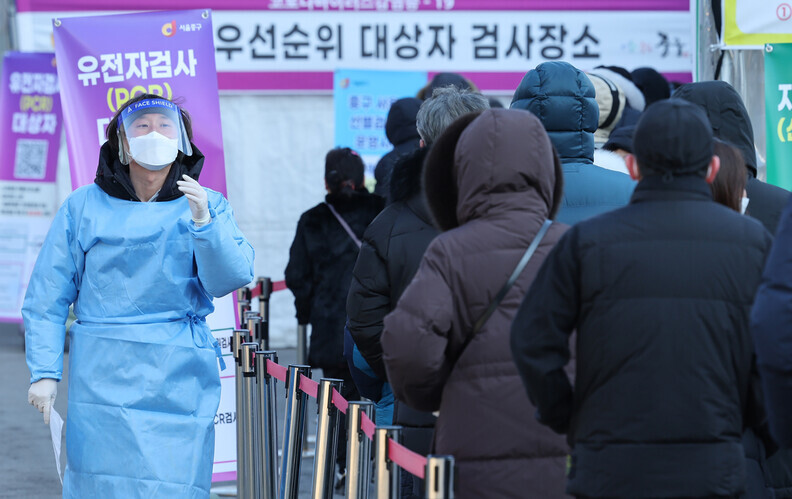hankyoreh
Links to other country sites 다른 나라 사이트 링크
Total COVID-19 cases in S. Korea double to 2 million in span of 2 weeks

Korea exceeded 2 million cumulative cases of COVID-19 on Monday. While it took more than two years for Korea to reach 1 million cases of the coronavirus on Feb. 6, it only took two weeks to add another million amid the Omicron wave. That’s prompting experts to say that Korea needs to assess whether the health care system in its current state can handle 2,000 critically ill patients.
Korea reported Sunday that 104,829 more people had tested positive for COVID-19 the previous day, with the daily tally topping 100,000 for the third day in a row. Korea’s cumulative case tally stood at 1,962,837 Sunday, with official numbers hitting 2,058,184 as of Monday morning.
While the severe case incidence rate (0.42%) for the Omicron variant is one-third of the Delta variant’s (1.4%), the Omicron wave is so large that patients with serious and critical cases are trending upward. The number of such critically ill patients had remained in the 200-299 range from Jan. 29 until Feb. 14, when it breached 300. The number rose above 400 on Saturday, just five days later.
While there’s still plenty of space in Korea’s COVID-19 hospital wards, the occupancy rate is gradually rising across the board. Intensive care units are at 32.5% occupancy, semi-intensive care units are at 56.6%, and dedicated infectious disease units are at 44.1%.
The government predicts the critically ill caseload will reach 2,000, which it describes as manageable. “Experts are predicting that we’ll be seeing around 180,000 [daily cases] on March 2. We predict there will be between 1,000 and 2,500 critically ill patients,” said Lee Gi-il, a senior official with the Ministry of Health and Welfare.
Given the difficulty of predicting the exact degree to which cases will increase, some experts say the government should prepare for the worst.
Korea’s National Institute for Mathematical Sciences estimated on Feb. 9 that the daily caseload would peak at 360,000 cases on March 2 — much higher than the government’s prediction of 130,000-170,000. The institute’s predictions about COVID-19 caseload trends, which it has made in biweekly reports, are regarded as being fairly accurate.
In addition, the government eased pandemic restrictions on Friday by allowing businesses to stay open an extra hour, until 10 pm.
“A one-hour extension will allow restaurants to serve more customers, allowing them to serve two batches of customers in the evening, and turnover could increase 20%-30%. The government needs to inform the public about the worst-case scenario of more than 2,500 critically ill people,” said Choi Jae-wook, a professor of preventive medicine at Korea University College of Medicine.
“Even if critical cases occur on the scale expected [by the government], the health care system could be paralyzed as doctors and nurses get infected unless we slow things down,” said Choe Kang-won, a professor of infectious disease at Myongji Hospital.
There are now 450,493 COVID-19 patients undergoing at-home care, up more than 200,000 from the week before. After a male patient in his 50s was found dead on Friday in his home in Seoul’s Gwanak District, where he’d been staying apart from his family, experts are urging the government not to neglect at-home patients, which can lead to serious and even fatal cases of the disease.
“In other countries, doctors personally provide face-to-face care for patients [at home]. Rather than uniformly imposing categorization standards for at-home patients, we need to set up a system so that the doctor can check on a new patient’s status and make decisions about hospitalization, at-home treatment and prescriptions,” Choe said.
By Park June-yong, staff reporter
Please direct questions or comments to [english@hani.co.kr]

Editorial・opinion
![[Guest essay] Preventing Korean Peninsula from becoming front line of new cold war [Guest essay] Preventing Korean Peninsula from becoming front line of new cold war](https://flexible.img.hani.co.kr/flexible/normal/500/300/imgdb/original/2024/0507/7217150679227807.jpg) [Guest essay] Preventing Korean Peninsula from becoming front line of new cold war
[Guest essay] Preventing Korean Peninsula from becoming front line of new cold war![[Column] The state is back — but is it in business? [Column] The state is back — but is it in business?](https://flexible.img.hani.co.kr/flexible/normal/500/300/imgdb/original/2024/0506/8217149564092725.jpg) [Column] The state is back — but is it in business?
[Column] The state is back — but is it in business?- [Column] Life on our Trisolaris
- [Editorial] Penalties for airing allegations against Korea’s first lady endanger free press
- [Editorial] Yoon must halt procurement of SM-3 interceptor missiles
- [Guest essay] Maybe Korea’s rapid population decline is an opportunity, not a crisis
- [Column] Can Yoon steer diplomacy with Russia, China back on track?
- [Column] Season 2 of special prosecutor probe may be coming to Korea soon
- [Column] Park Geun-hye déjà vu in Yoon Suk-yeol
- [Editorial] New weight of N. Korea’s nuclear threats makes dialogue all the more urgent
Most viewed articles
- 1[Guest essay] Preventing Korean Peninsula from becoming front line of new cold war
- 260% of young Koreans see no need to have kids after marriage
- 3Yoon’s broken-compass diplomacy is steering Korea into serving US, Japanese interests
- 4After 2 years in office, Yoon’s promises of fairness, common sense ring hollow
- 5[Column] Why Korea’s hard right is fated to lose
- 6S. Korean first lady likely to face questioning by prosecutors over Dior handbag scandal
- 7Is Japan about to snatch control of Line messenger from Korea’s Naver?
- 8[Column] The state is back — but is it in business?
- 946% of cases of violence against women in Korea perpetrated by intimate partner, study finds
- 10[Column] The first year of war in Ukraine